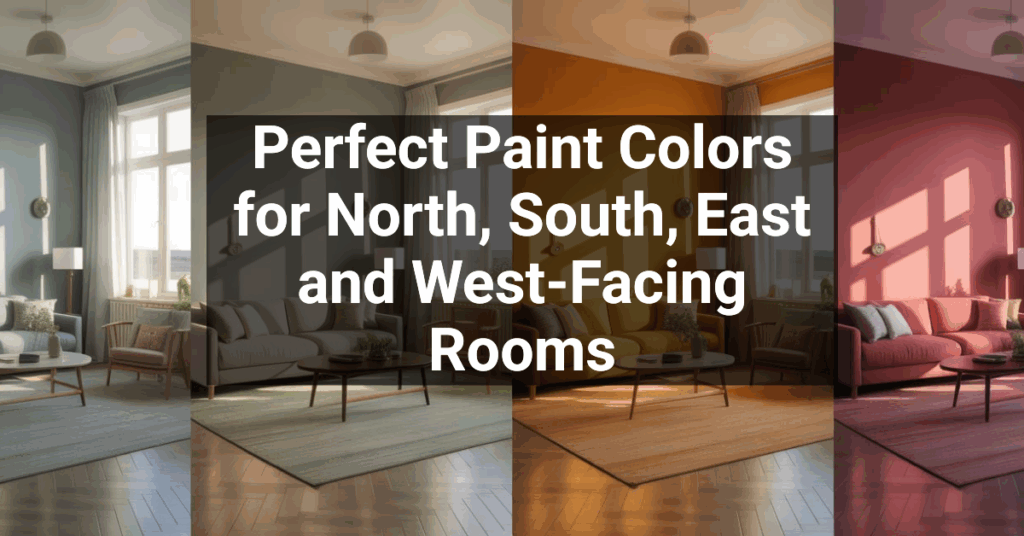A well-styled shelf can instantly take a room from plain to something out of a magazine. Whether you’ve got built-in bookcases or just a few floating shelves, the right setup adds personality and makes your space more interesting.
Remember to repin your favorite images!
Here’s the real trick: balance vertical and horizontal elements, and mix your books with decorative objects that actually mean something to you.
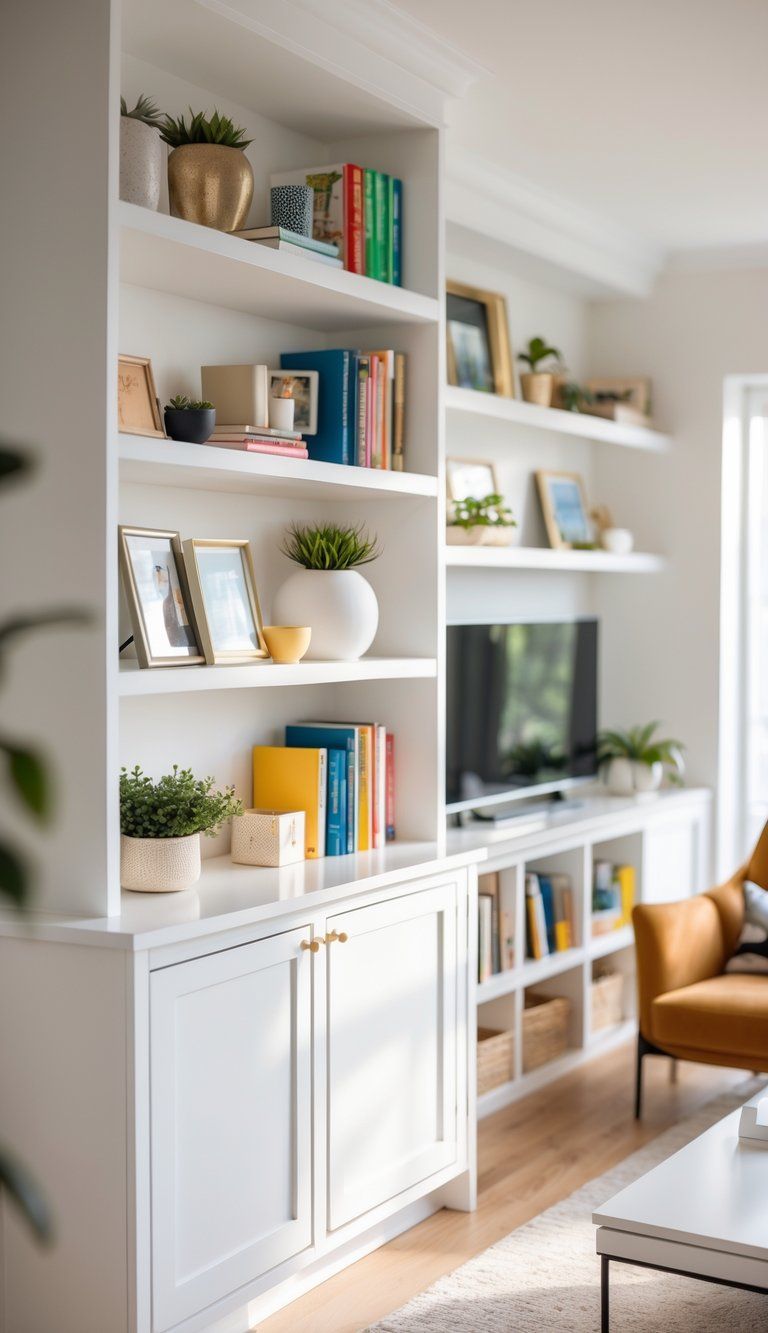
Empty shelves? Think of them as blank canvases begging for a bit of creativity. Start by clearing everything off and planning a mix that includes books, framed photos, and objects that tell your story.
Try color-coding your books, playing with different heights, and making small vignettes. These simple tricks will help guide the eye and keep things visually appealing.
Don’t cram every inch with stuff—negative space matters just as much as the things you display. The best shelves look like you’ve collected items over time, not like you bought everything in one afternoon.
Take your time and play around with arrangements. Sometimes you have to move things a few times before it feels right. Don’t be afraid to tweak as you go until it looks polished but still feels like you.
Understanding Shelf Styling Fundamentals
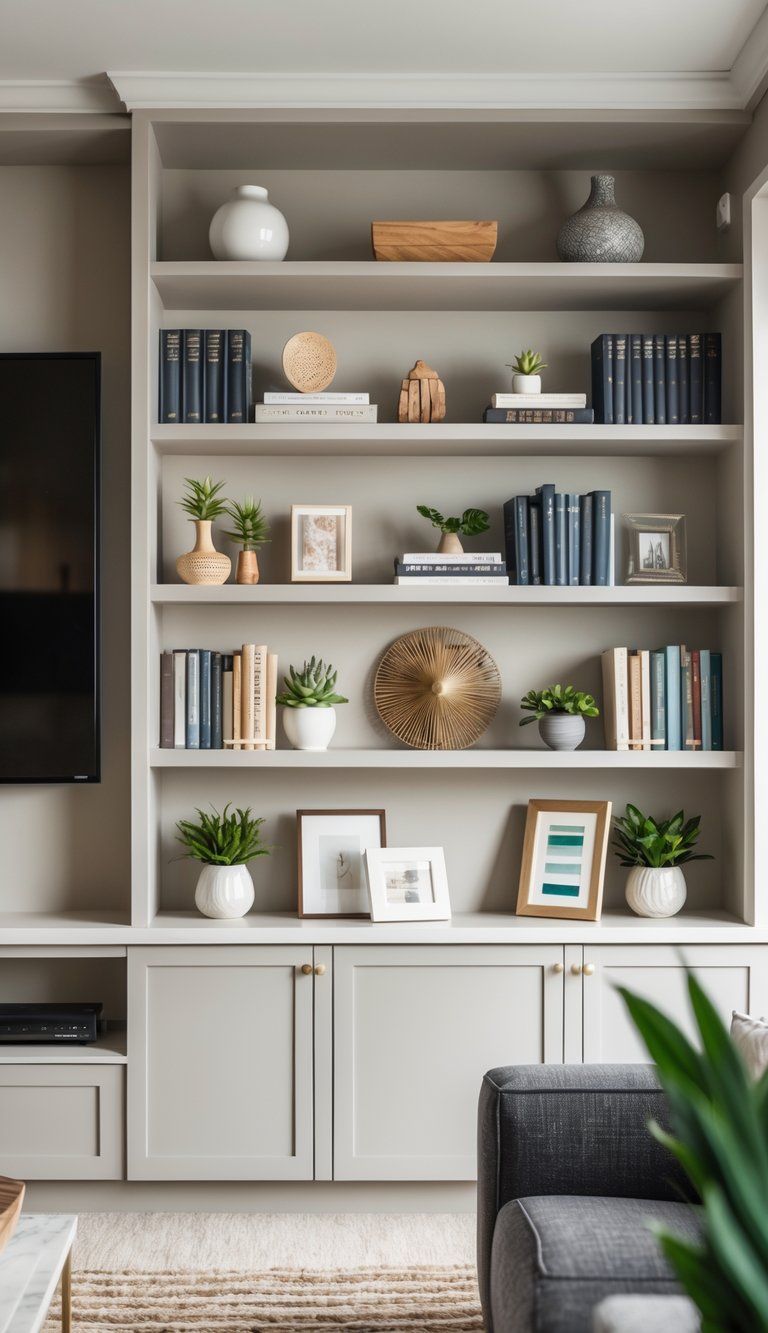
When you style shelves well, you turn basic storage into a feature that shows off your style. The right mix balances visual interest with function, and creates little focal points that draw attention.
Why Shelf Styling Matters
Well-styled shelves can totally change the vibe in a room. They show off who you are and what you love, while making the whole space feel more finished.
Cluttered or empty shelves, on the other hand, can make a room feel messy or unfinished.
When you nail the styling, you turn functional storage into a design statement. Suddenly, your bookshelves become conversation starters, not just a place to stash stuff.
Your shelves also help set the overall look of your home. Whether you love minimalism, something more eclectic, or a traditional feel, your shelf arrangement can reinforce your style in a subtle way.
Key Elements of Shelf Styling
Height variation keeps things interesting. Mix tall and short items so your eyes move naturally across the shelves.
Texture gives shelves some depth. Throw in:
- Smooth ceramics
- Rough, natural elements
- Soft textiles
- Metallic accents
Color coordination ties everything together. Stick to a limited palette that works with your room, but don’t stress about matching everything perfectly—contrast adds a nice touch.
Books lay the groundwork for great shelf styling. Stack them both ways—some vertical, some horizontal—for variety. Leave space between objects; about 70% full and 30% empty usually looks good.
Visual Balance and Harmony
Balance doesn’t mean everything has to be perfectly symmetrical. Instead, spread out the visual weight. If you put a big item on one side, balance it with a cluster of smaller things on the other.
Try the “triangle method“—arrange objects so their heights form a triangle, which naturally leads the eye across the shelf.
Pay attention to scale. Tiny things can disappear on big shelves, while huge pieces might overwhelm smaller built-ins.
Push some items forward and tuck others back to add depth.
Grouping items in odd numbers—especially threes—usually looks more natural and interesting. There’s just something about it that feels right.
Selecting the Right Shelves for Your Space
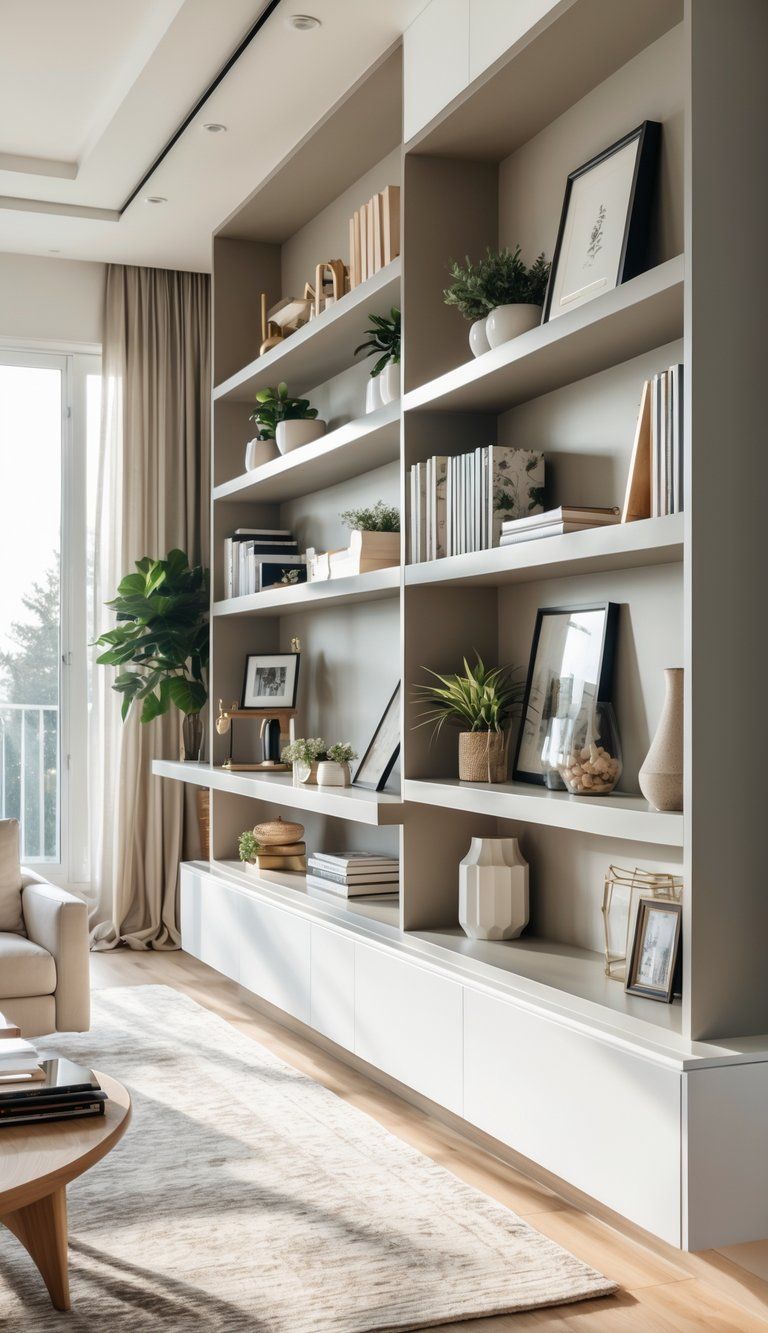
Getting your shelves right starts with picking ones that fit your style and actually work for your needs. The type of shelf you choose can totally change both the look and how useful your room is.
Choosing Between Bookcases and Built-in Shelves
Built-in shelves give you a custom, polished look that makes the most of your space. They blend right into the walls and can reach awkward corners or go all the way to the ceiling.
Built-ins add value to your home and feel like a permanent feature.
Freestanding bookcases are way more flexible. You can move them around or take them with you if you move. They come in all sorts of styles, from modern to classic.
If you’re setting up a home office, think about shelf depth. Deeper shelves (10-12 inches) fit big binders and art books, while narrower ones (6-8 inches) are great for paperbacks and decor.
Custom vs. Ready-Made Options
Custom built-ins fit your space perfectly. You can choose the exact dimensions, materials, and even add features like built-in lighting or cabinets underneath.
They do cost more, but they make odd spaces work and can match existing trim or woodwork.
Ready-made shelves from places like Target or Amazon are easier on the wallet. Many are modular, so you can add more over time. Look for solid wood or sturdy composites so they don’t sag.
Semi-custom options are worth a look too. Some companies offer standard sizes with a few custom features, like adjustable shelves or different finishes. It’s a nice middle ground if you want something unique without the custom price tag.
Curating Items for Shelf Styling
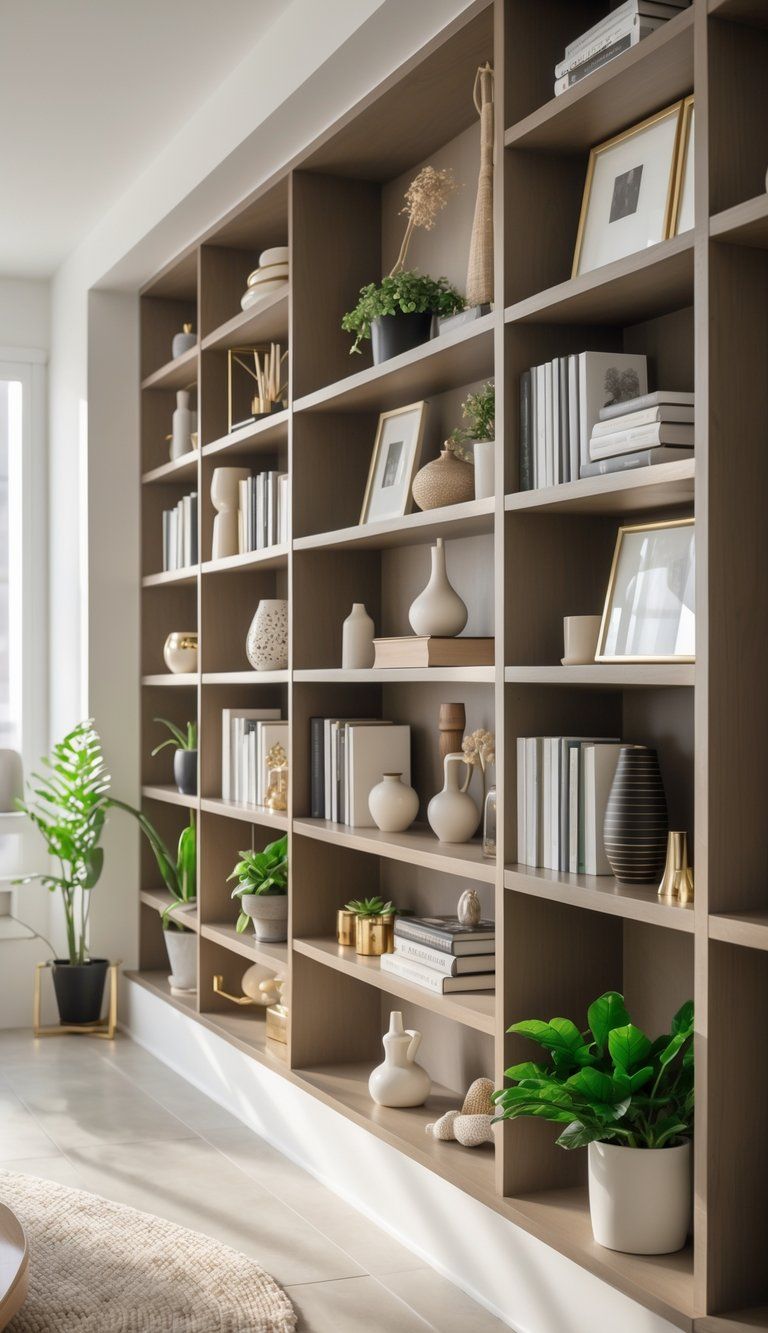
Picking the right mix of items is what makes shelves look like a designer styled them. The things you choose should feel personal but still look good together.
Balancing Books and Decorative Objects
Books are the backbone of any well-styled shelf. Stack them vertically and horizontally to break things up. Try grouping 3-5 books by size or color to keep it looking tidy.
Mix in decorative objects between the books. Good choices include:
- Small sculptures
- Decorative boxes
- Souvenirs that matter to you
- Quirky bookends
A 60/40 split between books and decor usually works, but adjust to fit your collection. Bookcases might need more books, while open shelves often shine with more decorative pieces.
Leave gaps between things. Overcrowding just makes everything look messy.
Layering Decorative Items
Layering adds depth and makes shelves feel more dynamic. Put taller items at the back and smaller ones up front.
Leaning framed art or photos against the wall (instead of hanging them) gives a relaxed, collected look.
Create little vignettes by grouping 3-5 items of different heights. Odd numbers, especially threes, usually look best—designers swear by it.
Add natural elements like potted plants or succulents for a bit of life. Plants with trailing vines are especially nice for upper shelves.
Mix up textures, too. Pair smooth ceramics with rough wood or stone for a more interesting display.
Showcasing Book Collections
If you’re a serious book lover, organize your books in a way that’s both practical and pleasing. Color-coding looks striking, but grouping by genre or author makes things easier to find.
Show off some books by facing them outward—especially if they have beautiful covers. Vintage books with cool spines can double as decor, even if you don’t read them much.
For paperbacks or less attractive books, take off the dust jackets or stick them on lower shelves. Save eye-level spots for your best-looking volumes.
If you collect a series, keep the whole set together. Add a related object nearby to highlight your interest.
Incorporating Texture and Color
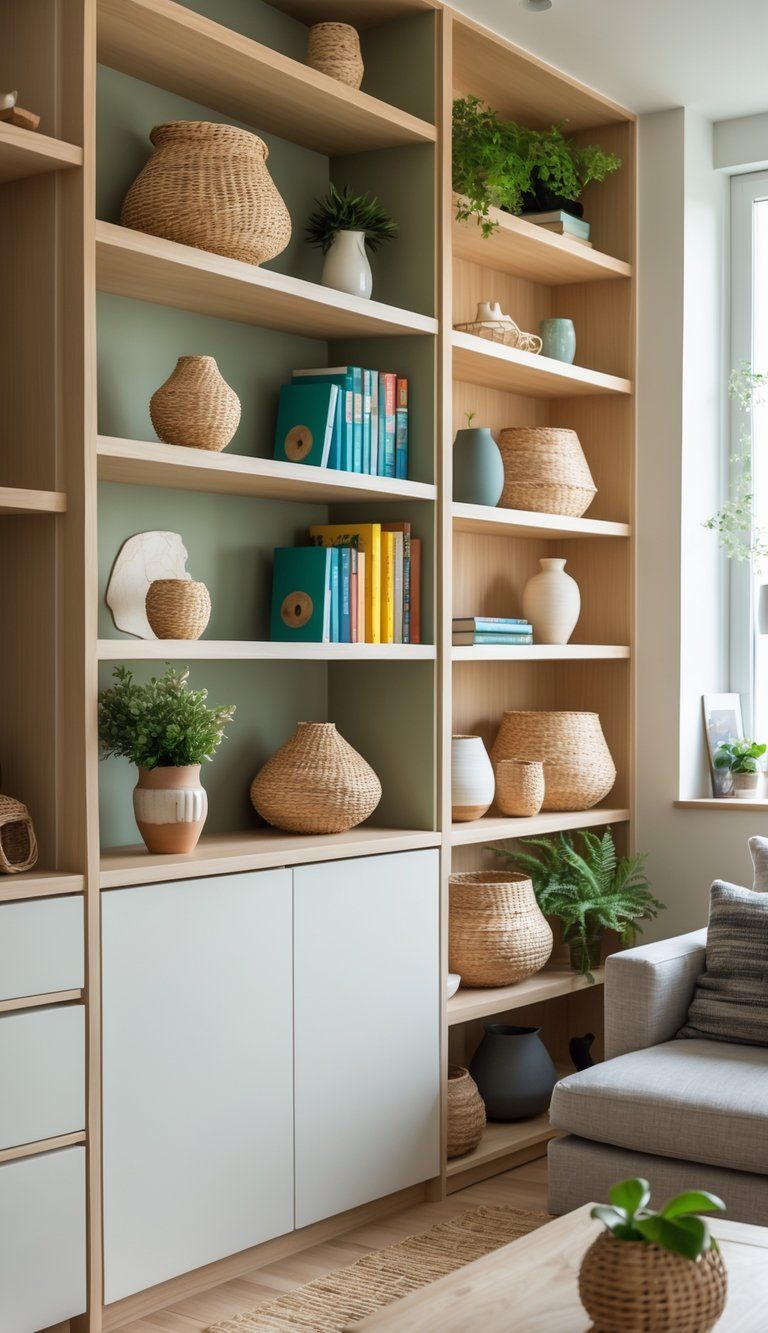
Texture and color are what make shelves pop. They help turn plain storage into something you actually want to look at.
Using Natural Elements and Greenery
Plants breathe life and organic texture into any shelf. Try small potted succulents between books, or let a trailing ivy spill over the side. Greenery just plays so well against books and decor.
Natural materials like woven baskets, wood, or stone bookends add texture and warmth. Even something as simple as a piece of driftwood can become a cool accent.
Mix up your materials for balance. Put a shiny ceramic vase next to something rough like coral or shells. It just makes things more interesting.
Swap in seasonal bits to keep shelves feeling fresh. Pine cones in winter, shells in summer, or a vase of flowers in spring can all change the vibe.
Adding Pops of Color
Color can totally transform shelves. Here are a few ways to do it:
- Color blocking: Group books by spine color for a bold, organized look.
- Accent pieces: Use bright vases, frames, or objects as focal points.
- Neutrals with pops: Stick to neutrals, then add a few bright accents for interest.
Metallics add another layer—think a brass figurine, copper bookend, or silver frame. They catch the light and give a little extra sparkle.
The color of your shelf matters, too. White shelves make colors stand out, while dark wood gives a more dramatic backdrop. Let your shelf color guide how bold you go with decor.
Art and colorful book jackets can add instant color, too. Just turn a few favorite covers face-out for a quick update.
Practical Storage Solutions
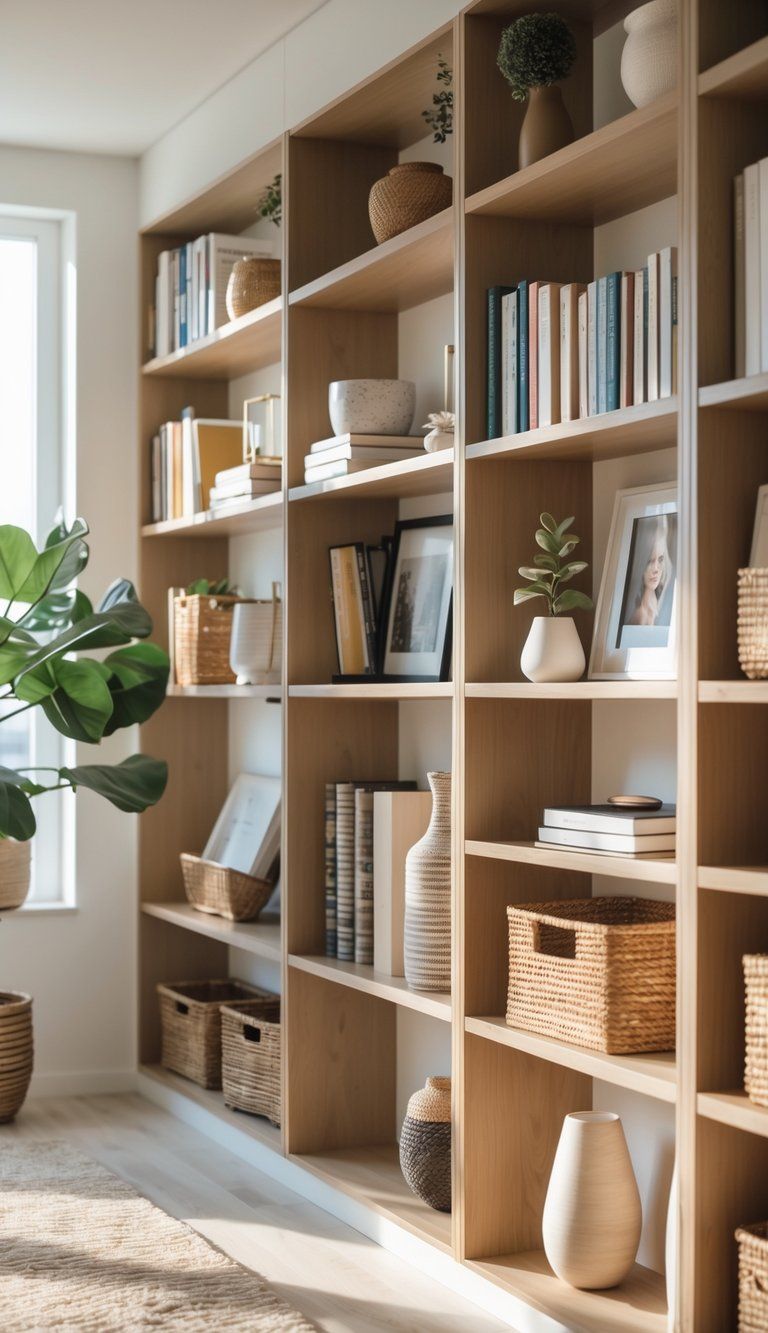
Stylish shelves don’t mean you have to give up on practicality. The right storage solutions keep things looking good and working for you.
Organizing with Baskets and Decorative Boxes
Woven baskets hide clutter and add texture. Pick sizes that actually fit your shelves—small ones for narrow spots, bigger ones for deep shelves.
Natural materials like seagrass or rattan work with almost any style. For a pulled-together look, stick to baskets in similar colors or shapes.
Decorative boxes are another clever option. Tuck away:
- Cords and chargers
- Office supplies
- Kids’ toys
- Seasonal odds and ends
Labels make it easier to find things without messing up your display. In playrooms or craft spaces, clear bins are handy when you need to see what’s inside.
Combining Storage and Visual Interest
Mix storage with decor to keep shelves both pretty and useful. For example, put a nice basket next to a stack of books, and maybe top it off with a little plant.
Try using storage pieces at the ends of a shelf, with decorative items in the middle. It adds structure and keeps things organized.
Color-code your storage bins for an extra design touch—blue for winter gear, green for spring, whatever makes sense for you.
Always leave some open space so things don’t feel packed in. A little breathing room goes a long way.
Styling Techniques for Professional Results
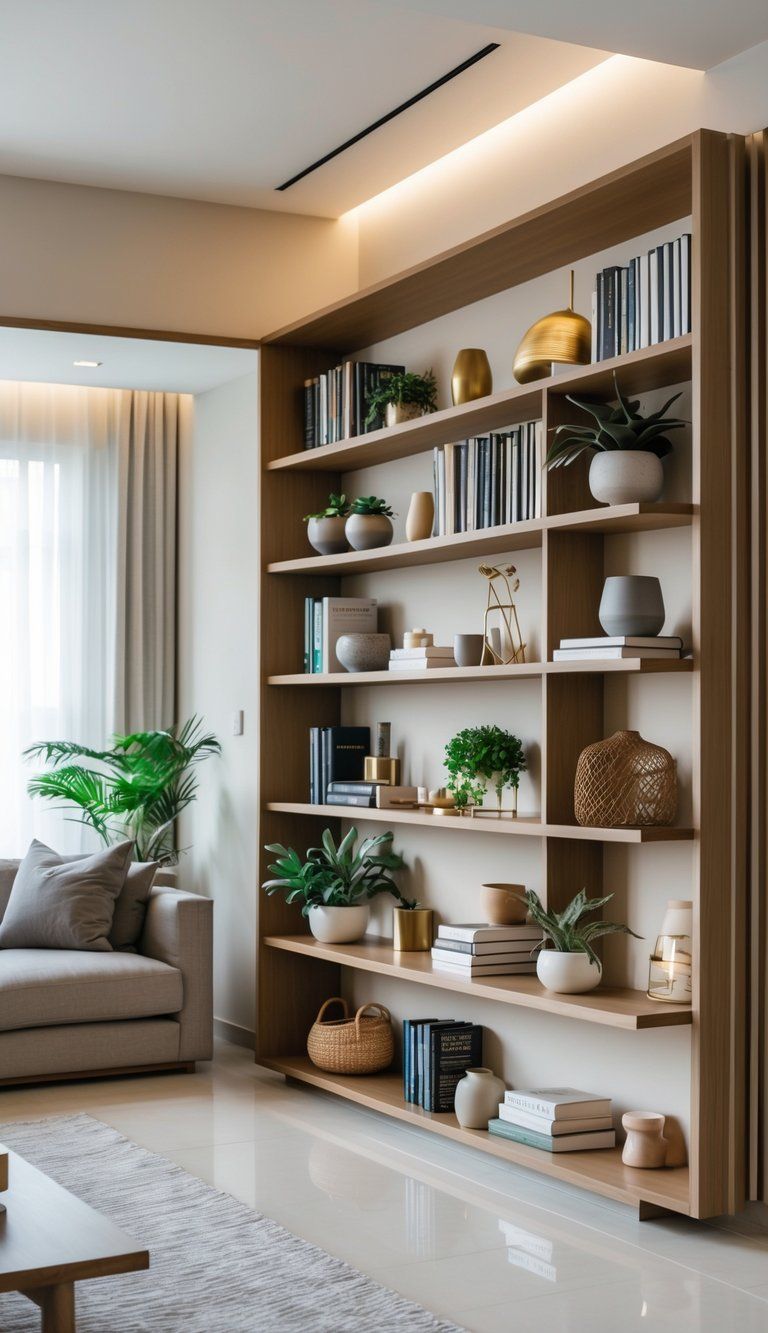
Stylish shelves rely on a few go-to techniques that designers use all the time. These tricks focus on creating visual interest through thoughtful arrangement and smart spacing.
Varying Heights and Shapes
If you want shelves that actually catch the eye, start by mixing up the heights and shapes of your items. When everything sits at the same level, the look falls flat—literally.
Set a tall vase or sculpture right next to something shorter. You’ll notice your eye just naturally wants to move around the display.
Here are a few combos that usually work:
- Tall book stacks with horizontal decorative boxes
- Medium-height plants beside small framed photos
- Vertical art pieces balanced out by wide, short bowls
Don’t line up everything at the same height. Create little “skylines” on each shelf by varying item heights. It’s a simple trick, but it really adds depth and keeps things interesting.
Layering for Depth
Layering might sound fancy, but it’s just about putting some things in front of others instead of arranging everything in a straight line. This shelf display technique adds a sense of depth and feels a bit more intentional.
Start with your biggest pieces at the back. Lean a frame or some artwork as your backdrop, then add smaller things in front.
A few layering ideas:
- Tuck a decorative box behind a little plant or a quirky figurine
- Lean a framed photo against a stack of books, then pop a small object up front
- Stack books horizontally and set a decorative piece on top
Don’t go overboard—stick to two or three layers deep. Too many and suddenly it’s all chaos, not style.
Effective Use of Negative Space
Negative space, or just the empty bits between objects, matters way more than you might think. It gives your shelves a chance to breathe and stops everything from feeling crammed together.
Try not to fill every inch. Leave some spots totally empty—it actually helps your favorite pieces stand out instead of getting lost in the crowd.
Some ways to use negative space:
- Group items together, but leave gaps between those clusters
- Leave one part of a shelf blank for a visual pause
- Go for asymmetrical layouts—don’t center everything
Try the 70/30 rule: fill about 70% of the shelf, and leave 30% open. That way, your display feels intentional but never sparse or cluttered.
Personalizing Your Shelf Styling
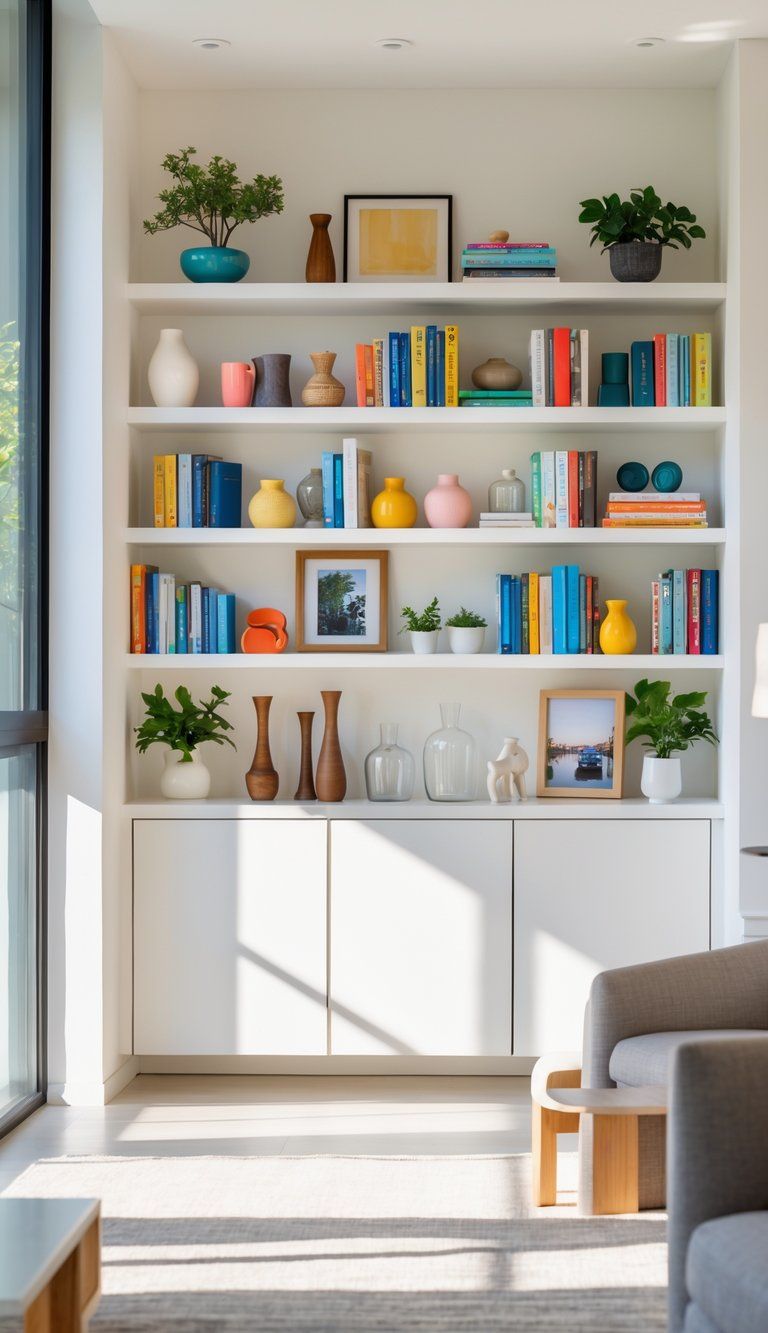
Shelves really come alive when you add your unique story. The best displays mix a bit of designer know-how with personal touches that make the space feel like you.
Displaying Unique Collectibles
Collections shine most when you display them as a group, not scattered all over the place. Three vintage cameras lined up together will always catch more attention than one on each shelf.
Arrange collectibles at different heights for a “shelfie” moment. Put the tallest in back, shortest up front, and you’ll create instant depth. Most designers say to stick to 3-5 items per shelf so things don’t get too busy.
Switch out collections with the seasons if you can. It keeps the look fresh and lets you show off more of your favorites over time.
Travel souvenirs, quirky vintage finds, or hobby items bring a kind of character you just can’t buy at a big box store.
Incorporating Sentimental Touches
Family photos instantly warm up a shelf. Try to pick frames that match your vibe—uniform frames feel tidy, but mixing it up can look cool and collected.
Don’t go overboard with pictures. Pick a handful you love and rotate them. Odd numbers (like 3 or 5) create groupings that feel balanced, or so the experts say.
Mix in objects that mean something, like a shell from your favorite beach trip or your grandma’s tiny dish. Those little details are the ones only you and your family really “get.”
You could even create little themed vignettes. Maybe one shelf holds memories from a special trip—photos, a souvenir, and a book about the place.
It’s these personal touches that make your home feel like yours, even when it looks professionally styled.
Shelf Styling Ideas for Different Rooms
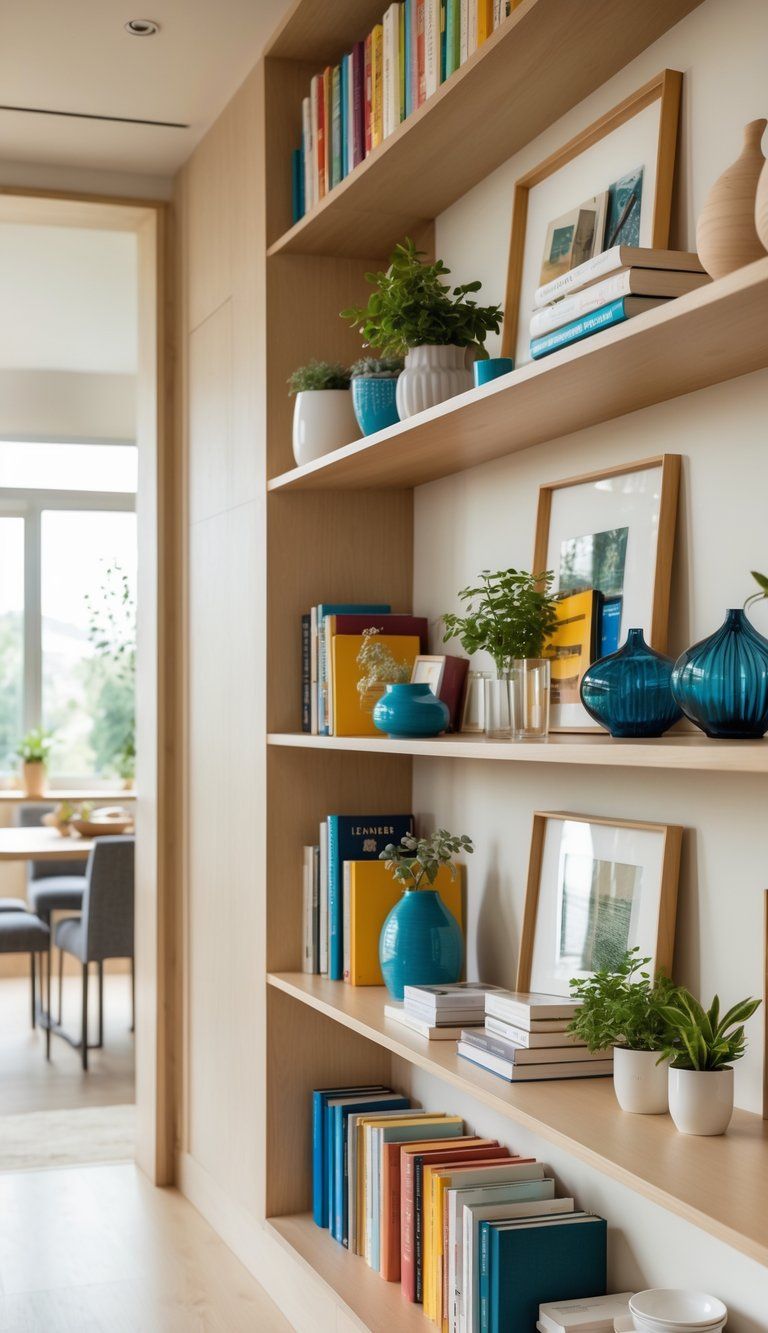
Every room in your house offers its own shelf-styling opportunities. What works in one space might not fit another, so let each room’s purpose guide your choices.
Living Room Shelf Styling
Living room shelves need to balance your personal story with a bit of visual polish. Pick a color scheme that plays nicely with your décor. Groups of three objects usually look best.
Books and Decorative Objects Mix:
- Place books both upright and stacked to mix things up
- Use quirky bookends for personality
- Leave 20-30% of the shelf empty to avoid that overstuffed look
Add some family photos for warmth, but don’t let them steal the show. Rotate in seasonal pieces to keep things lively. Plants, especially trailing ones like pothos, bring life to upper shelves, while succulents work well lower down.
Try frames in different sizes for more dimension. Put heavier or bigger items on the bottom shelves for stability. Your living room shelves should feel like you, but still look put-together.
Home Office Arrangements
Shelving in your home office needs to work for you but shouldn’t be boring. Start with a setup that actually helps your workflow and still looks good.
Practical Office Shelf Organization:
- Bottom shelves: Stash reference books or things you grab all the time
- Middle shelves: Mix in decorative objects with supplies you don’t use as often
- Top shelves: Store archives or show off purely decorative stuff
Hide away supplies in nice baskets or boxes to keep things tidy. Label boxes for papers or small items you need, but don’t want to see every day.
Add a few personal objects that spark creativity—a plant, some art, or a favorite trinket. Leave a little space around important items to help them stand out.
Think about what’s behind you on video calls. Place meaningful books, certificates, or a simple decorative piece in the background to look professional without being distracting.
Styling Built-in Bookshelves in Entryways
Entryway built-ins make a bold first impression when someone steps into your home. They should look good but also help you stay organized—why not let them set the whole vibe for your space?
Try to keep entryway shelves simple. No one wants to see a messy collection right when they walk in. Make sure you have a spot for keys, mail, and all those bits you grab every day.
Entryway Shelf Essentials:
- A decorative tray to catch your small stuff
- A mirror (because who doesn’t want one last look before heading out?)
- A little plant or some fresh flowers to add a bit of life
If you can, add some lighting. A small lamp or a picture light can make the space feel warmer and really show off your favorite pieces. Switching up your décor with the seasons? That’s a fun way to keep things interesting.
If your built-ins have cabinets below, stash shoes and anything else you don’t want on display down there. Keep the open shelves up top simple, with just a few statement pieces—sometimes less really is more.

